Towards Sustainable Business Model Innovation for the Pharmaceutical Industry
Abstract
:1. Introduction
1.1. Research Motives
1.2. Research Purpose
- (1)
- A review of the literature in Taiwan and overseas on business model innovation, sustainable business models, and the circular economy in order to conceptualize the dimensions of sustainable business models and conduct a statistical analysis accordingly;
- (2)
- An exploration of the substance of sustainable business models for the pharmaceutical industry from the process perspective;
- (3)
- A deep-dive into the details of sustainable business models for the pharmaceutical industry via a literature review and a focus group discussion, so as to analyze the key dimension and processes and then develop a unique sustainable business model;
- (4)
- An evaluation of the causal relationship in the sustainable business model for the pharmaceutical industry by delving into the factors such as external environments, innovative support from management and the correlation between company performance and sustainable business models.
1.3. Research Questions
1.4. Research Flow
2. Literature Review
- (1)
- (2)
- (3)
- (4)
3. Methods, Results, and Discussion
3.1. Construction Stage
3.1.1. Study 1: Conceptualization of Sustainable Business Model Dimension
Exploratory Factor Analysis (EFA)
- (1)
- A total of three factors was extracted with factor analysis on the technological dimension of sustainable business models. There was a total of 14 questions, and all the questions had a factor loading of above 0.6, i.e., higher than the threshold of 0.5 in absolute value. In terms of reliability, all the coefficients for individual items were greater than 0.5, and the cumulative explained variances reached 88.811. Moreover, the Cronbach’s α values of all the factors were higher than the reliability threshold of 0.8, indicative of a good internal questionnaire consistency. The factors are named below (detailed numbers are shown in Table 1).
- (2)
- A total of three factors was extracted with factor analysis on the social dimension of sustainable business models. There was a total of 11 questions, and all the questions had a factor loading of above 0.6, i.e., higher than the threshold of 0.5 in absolute value [35]. In terms of reliability, all the coefficients for individual items were greater than 0.5, and the cumulative explained variances reached 87.576. The Cronbach’s α values of all the factors were higher than the reliability threshold of 0.8, indicative of good internal questionnaire consistency. The factors are named below (detailed numbers are shown in Table 2).
- (1)
- A total of two factors was extracted with the factor analysis on the organizational dimension of sustainable business models. There was a total of 10 questions, and all the questions had a factor loading of above 0.6, i.e., higher than the threshold of 0.5 in absolute value [35]. As far as reliability is concerned, all the coefficients for individual items were greater than 0.5, and the cumulative explained variances reached 67.391. Moreover, the Cronbach’s α values of all the factors were higher than the reliability threshold of 0.8, indicative of good internal questionnaire consistency. The factors are named below (detailed numbers are shown in Table 3).
3.1.2. Study 2: Process Development for Sustainable Business Models
3.1.3. Study 3: Development of Unique Sustainable Business Models
3.2. Empirical Stage
3.2.1. Research Framework and Research Sample
3.2.2. Hypothesis Tests
4. Conclusions and Research Limitations
4.1. Conclusions
- (1)
- Implications of conceptualized BMI
- (2)
- Implications of BMI as a process for organizational change
- (3)
- Implications of unique BMI development
- (4)
- Implication of the causal relationships in the sustainable business models for the Taiwanese pharmaceutical industry
- (1)
- The development process of sustainable business model innovations is, in its own right, the process of organizational innovation. This research develops a process for the technological, social, and organizational dimensions for the pharmaceutical industry and maps the path for organizational change for this industry in three dimensions. This improves the feasibility of strategic mapping and KPI establishment.
- (2)
- Many frameworks have been developed in recent years by integrating corporate sustainability and traditional business models. Examples include social business models, green business models, triple-bottom-line business models, green business models, social-development business models, inclusive business models, and sustainable business models. These concepts have been applied to social and corporate issues. Going forward, vision and mission statements for companies will go beyond profitability. Sustainability and innovation will become the most important strategic options for corporate management.
4.2. Research Limitations and Future Research
Author Contributions
Funding
Institutional Review Board Statement
Informed Consent Statement
Data Availability Statement
Conflicts of Interest
Appendix A
| Sustainable Business Model (SBM) | ||||||
|---|---|---|---|---|---|---|
| 1 | 2 | 3 | 4 | 5 | 6 |
| 1 | 2 | 3 | 4 | 5 | 6 |
| 1 | 2 | 3 | 4 | 5 | 6 |
| 1 | 2 | 3 | 4 | 5 | 6 |
| 1 | 2 | 3 | 4 | 5 | 6 |
| 1 | 2 | 3 | 4 | 5 | 6 |
| 1 | 2 | 3 | 4 | 5 | 6 |
| 1 | 2 | 3 | 4 | 5 | 6 |
| 1 | 2 | 3 | 4 | 5 | 6 |
| 1 | 2 | 3 | 4 | 5 | 6 |
| 1 | 2 | 3 | 4 | 5 | 6 |
| 1 | 2 | 3 | 4 | 5 | 6 |
| 1 | 2 | 3 | 4 | 5 | 6 |
| 1 | 2 | 3 | 4 | 5 | 6 |
| 1 | 2 | 3 | 4 | 5 | 6 |
| 1 | 2 | 3 | 4 | 5 | 6 |
| 1 | 2 | 3 | 4 | 5 | 6 |
| 1 | 2 | 3 | 4 | 5 | 6 |
| 1 | 2 | 3 | 4 | 5 | 6 |
| 1 | 2 | 3 | 4 | 5 | 6 |
| 1 | 2 | 3 | 4 | 5 | 6 |
| 1 | 2 | 3 | 4 | 5 | 6 |
| 1 | 2 | 3 | 4 | 5 | 6 |
| 1 | 2 | 3 | 4 | 5 | 6 |
| 1 | 2 | 3 | 4 | 5 | 6 |
| 1 | 2 | 3 | 4 | 5 | 6 |
| 1 | 2 | 3 | 4 | 5 | 6 |
| 1 | 2 | 3 | 4 | 5 | 6 |
| 1 | 2 | 3 | 4 | 5 | 6 |
| 1 | 2 | 3 | 4 | 5 | 6 |
| 1 | 2 | 3 | 4 | 5 | 6 |
| 1 | 2 | 3 | 4 | 5 | 6 |
| 1 | 2 | 3 | 4 | 5 | 6 |
| 1 | 2 | 3 | 4 | 5 | 6 |
| 1 | 2 | 3 | 4 | 5 | 6 |
| Innovation Support | ||||||
|---|---|---|---|---|---|---|
| 1 | 2 | 3 | 4 | 5 | 6 |
| 1 | 2 | 3 | 4 | 5 | 6 |
| 1 | 2 | 3 | 4 | 5 | 6 |
| 1 | 2 | 3 | 4 | 5 | 6 |
| 1 | 2 | 3 | 4 | 5 | 6 |
| 1 | 2 | 3 | 4 | 5 | 6 |
| 1 | 2 | 3 | 4 | 5 | 6 |
| 1 | 2 | 3 | 4 | 5 | 6 |
| 1 | 2 | 3 | 4 | 5 | 6 |
| 1 | 2 | 3 | 4 | 5 | 6 |
| 1 | 2 | 3 | 4 | 5 | 6 |
| 1 | 2 | 3 | 4 | 5 | 6 |
| 1 | 2 | 3 | 4 | 5 | 6 |
| 1 | 2 | 3 | 4 | 5 | 6 |
| Perceive the Uncertainty of the External Environment | ||||||
|---|---|---|---|---|---|---|
| 1 | 2 | 3 | 4 | 5 | 6 |
| 1 | 2 | 3 | 4 | 5 | 6 |
| 1 | 2 | 3 | 4 | 5 | 6 |
| 1 | 2 | 3 | 4 | 5 | 6 |
| 1 | 2 | 3 | 4 | 5 | 6 |
| 1 | 2 | 3 | 4 | 5 | 6 |
| 1 | 2 | 3 | 4 | 5 | 6 |
| Organizational Performance | ||||||
|---|---|---|---|---|---|---|
| 1 | 2 | 3 | 4 | 5 | 6 |
| 1 | 2 | 3 | 4 | 5 | 6 |
| 1 | 2 | 3 | 4 | 5 | 6 |
| 1 | 2 | 3 | 4 | 5 | 6 |
| Personal Information |
|---|
|
|
|
|
|
References
- Björkdahl, J.; Holmén, M. Business model innovation-the challenges ahead. Int. J. Prod. Dev. 2013, 18, 213–225. [Google Scholar]
- Rotondo, F.; Corsi, K.; Giovanelli, L. The social side of sustainable business models: An explorative analysis of the low-cost airline industry. J. Clean. Prod. 2019, 225, 806–819. [Google Scholar] [CrossRef]
- Snihur, Y.; Wiklund, J. Searching for innovation: Product, process, and business model innovations and search behavior in established firms. Long Range Plan. 2019, 52, 305–325. [Google Scholar] [CrossRef]
- Geissdoerfer, M.; Vladimirova, D.; Evans, S. Sustainable business model innovation: A review. J. Clean. Prod. 2018, 198, 401–416. [Google Scholar] [CrossRef]
- Baldassarre, B.; Konietazko, J.; Brown, P.; Calabretta, G.; Bocken, N.; Karpen, I.; Hultink, E. Industrial Symbiosis: Towards a design process for eco-industrial clusters by integrating Circular Economy and Industrial Ecology perspectives. J. Clean. Prod. 2019, 216, 446–460. [Google Scholar] [CrossRef]
- Foss, N.J.; Saebi, T. Fifteen Years of Research on Business Model Innovation: How Far Have We Come, and Where Should We Go? J. Manag. 2017, 43, 200–227. [Google Scholar] [CrossRef]
- Chuang, L.-M.; Chen, W.-J.; Yeh, C.-C. Business Model Innovation in Pharmaceutical industry: Service Orientation Perspective. Adv. Manag. Appl. Econ. 2019, 9, 1–7. [Google Scholar]
- Teece, D.J. Business Models, Business Strategy and Innovation. Long Range Plan. 2010, 43, 172–194. [Google Scholar] [CrossRef]
- Amit, R.; Zott, C. Creating value through business model innovation. MIT Solan Manag. Rev. 2012, 53, 40–49. [Google Scholar]
- Santos, J.; Spector, B.; Van der Heyden, L. Toward a Theory of Business Model Innovation within Incumbent Firms; INSEAD: Paris, France, 2009. [Google Scholar]
- De Reuver, M.; Bouwman, H.; Haaker, T. Business model roadmapping: A practical approach to come from an existing to a desired business model. Int. J. Innov. Manag. 2013, 17, 1340006. [Google Scholar] [CrossRef]
- Frankenberger, K.; Weiblen, T.; Csik, M.; Gassmann, O. The 4I-Framework of Business Model Innovation: A Structured View on Process Phases and Challenges. Int. J. Prod. Dev. 2013, 18, 249–273. [Google Scholar] [CrossRef]
- Girotra, K.; Netessine, S. OM Forum—Business Model Innovation for Sustainability. Manuf. Serv. Oper. Manag. 2013, 15, 537–544. [Google Scholar] [CrossRef]
- Pynnönen, M.; Hallikas, J.; Ritala, P. Managing customer-driven business model innovation. Int. J. Innov. Manag. 2012, 16, 1250022. [Google Scholar] [CrossRef]
- Holm, A.B.; Günzel, F.; Ulhøi, J.P. Openness in innovation and business models: Lessons from the newspaper industry. Int. J. Technol. Manag. 2013, 61, 324–348. [Google Scholar] [CrossRef]
- Karimi, J.; Walter, Z. Corporate Entrepreneurship, Disruptive Business Model Innovation Adoption, and Its Performance: The Case of the Newspaper Industry. Long Range Plan. 2016, 49, 342–360. [Google Scholar] [CrossRef]
- Schneider, S.; Spieth, P. Business model innovation: Towards an integrated future research agenda. Int. J. Innov. Manag. 2013, 17, 1340001. [Google Scholar] [CrossRef]
- Richter, M. Business model innovation for sustainable energy: German utilities and renewable energy. Energy Policy 2013, 62, 1226–1237. [Google Scholar] [CrossRef]
- Heinonen, K.; Holmlund, M.; Stra, T.; Witell, L.; Löfgren, M. From service for free to service for fee: Business model innovation in manufacturing firms. J. Serv. Manag. 2013, 24, 520–533. [Google Scholar]
- Visnjic Kastalli, I.; Van Looy, B. Servitization: Disentangling the impact of service business model innovation on manufacturing firm performance. J. Oper. Manag. 2013, 31, 169–180. [Google Scholar] [CrossRef]
- Aspara, J.; Hietanen, J.; Tikkanen, H. Business model innovation vs replication: Financial performance implications of strategic emphases. J. Strateg. Mark. 2010, 18, 39–56. [Google Scholar] [CrossRef]
- Bock, A.J.; Opsahl, T.; George, G.; Gann, D.M. The Effects of Culture and Structure on Strategic Flexibility During Business Model Innovation. J. Manag. Stud. 2012, 49, 279–305. [Google Scholar] [CrossRef]
- Cucculelli, M.; Bettinelli, C. Business models, intangibles and firm performance: Evidence on corporate entrepreneurship from Italian manufacturing SMEs. Small Bus. Econ. 2015, 45, 329–350. [Google Scholar] [CrossRef]
- Giesen, E.; Berman, S.J.; Bell, R.; Blitz, A. Three ways to successfully innovate your business model. Strategy Leadersh. 2007, 35, 27–33. [Google Scholar] [CrossRef]
- Stubbs, W.; Cocklin, C. Conceptualizing a “Sustainability Business Model”. Organ. Environ. 2008, 21, 103–127. [Google Scholar] [CrossRef]
- Porter, M.E.; Kramer, M.R. Creating shared value. Harv. Bus. Rev. 2011, 89, 62–77. [Google Scholar]
- Schaltegger, S.; Lüdeke-Freund, F.; Hansen, E.G. Business cases for sustainability: The role of business model innovation for corporate sustainability. Int. J. Innov. Sustain. Dev. 2012, 6, 95–119. [Google Scholar] [CrossRef]
- Magretta, J. Why Business Models Matter. Harv. Bus. Rev. 2002, 80, 86–92. [Google Scholar]
- Osterwalder, A.; Pigneur, Y.; Tucci, C. Clarifying Business Models: Origins, Present, and Future of the Concept. Commun. Assoc. Inf. Sci. 2005, 16, 1. [Google Scholar] [CrossRef]
- Boons, F.; Lüdeke-Freund, F. Business models for sustainable innovation: State-of-the-art and steps towards a research agenda. J. Clean. Prod. 2013, 45, 9–19. [Google Scholar] [CrossRef]
- Birkin, F.K.; Cashman, A.; Koh, S.C.L.; Liu, Z. New sustainable business models in China. Bus. Strategy Environ. 2009, 18, 64–77. [Google Scholar] [CrossRef]
- Bocken, N.M.P.; Short, S.W.; Rana, P.; Evans, S. A literature and practice review to develop sustainable business model archetypes. J. Clean. Prod. 2014, 65, 42–56. [Google Scholar] [CrossRef]
- Foss, N.J.; Saebi, T. Business models and business model innovation: Between wicked and paradigmatic problems. Long Range Plan. 2018, 51, 9–21. [Google Scholar] [CrossRef]
- Lavin, J.F.; Montecinos-Pearce, A.A. ESG Disclosure in an Emerging Market: An Empirical Analysis of the Influence of Board Characteristics and Ownership Structure. Sustainability 2021, 13, 10498. [Google Scholar] [CrossRef]
- Rutherford, G.S.W.; Hair, J.F.; Anderson, R.E.; Tatham, R.L. Multivariate Data Analysis with Readings. Statistician 1988, 37, 484. [Google Scholar] [CrossRef]
- Joyce, A.; Paquin, R.L. The triple layered business model canvas: A tool to design more sustainable business models. J. Clean. Prod. 2016, 135, 1474–1486. [Google Scholar] [CrossRef]
- Han, J.K.; Kim, N.; Srivastava, R.K. Market Orientation and Organizational Performance: Is Innovation a Missing Link? J. Mark. 1998, 62, 30–45. [Google Scholar] [CrossRef]
- Jaworski, B.J.; Kohli, A.K. Market Orientation: Antecedents and Consequences. J. Mark. 1993, 57, 53–70. [Google Scholar] [CrossRef]
- Andrews, H.I. The Concept of Corporate Strategy; Homewood: Kankakee, IL, USA, 1971. [Google Scholar]
- Boseman, F.G.; Phatak, A.V.; Schellenberger, R.E. Strategic Management: Text and Cases; John Wiley and Sons: Hoboken, NJ, USA, 1986. [Google Scholar]
- Robbins, P.; Maddock, T. Interrogating land cover categories: Metaphor and method in remote sensing. Cartogr. Geogr. Inf. Sci. 2000, 27, 295–309. [Google Scholar] [CrossRef]
- Miller, D.; Friesen, P.H. Innovation in conservative and entrepreneurial firms: Two models of strategic momentum. Strateg. Manag. J. 1982, 3, 1–25. [Google Scholar] [CrossRef]
- Kaplan, R.S.; Norton, D.P. Strategic Learning & the Balanced Scorecard. Strategy Leadersh. 1996, 24, 18–24. [Google Scholar]
- Amabile, T.M.; Conti, R.; Coon, H.; Lazenby, J.; Herron, M. Assessing the Work Environment for Creativity. Acad. Manag. J. 1996, 39, 1154–1184. [Google Scholar]
- Molina-Castillo, F.-J.; Sinkovics, N.; Sinkovics, R.R. Sustainable Business Model Innovation: Review, Analysis and Impact on Society. Sustainability 2021, 13, 8906. [Google Scholar] [CrossRef]
- Gomes, J.G.C.; Okano, M.T.; Guerra, R.S.; Cordeiro, D.d.S.; Santos, H.C.L.d.; Fernandes, M.E. Analysis of Sustainable Business Models: Exploratory Study in Two Brazilian Logistics Companies. Sustainability 2022, 14, 694. [Google Scholar] [CrossRef]
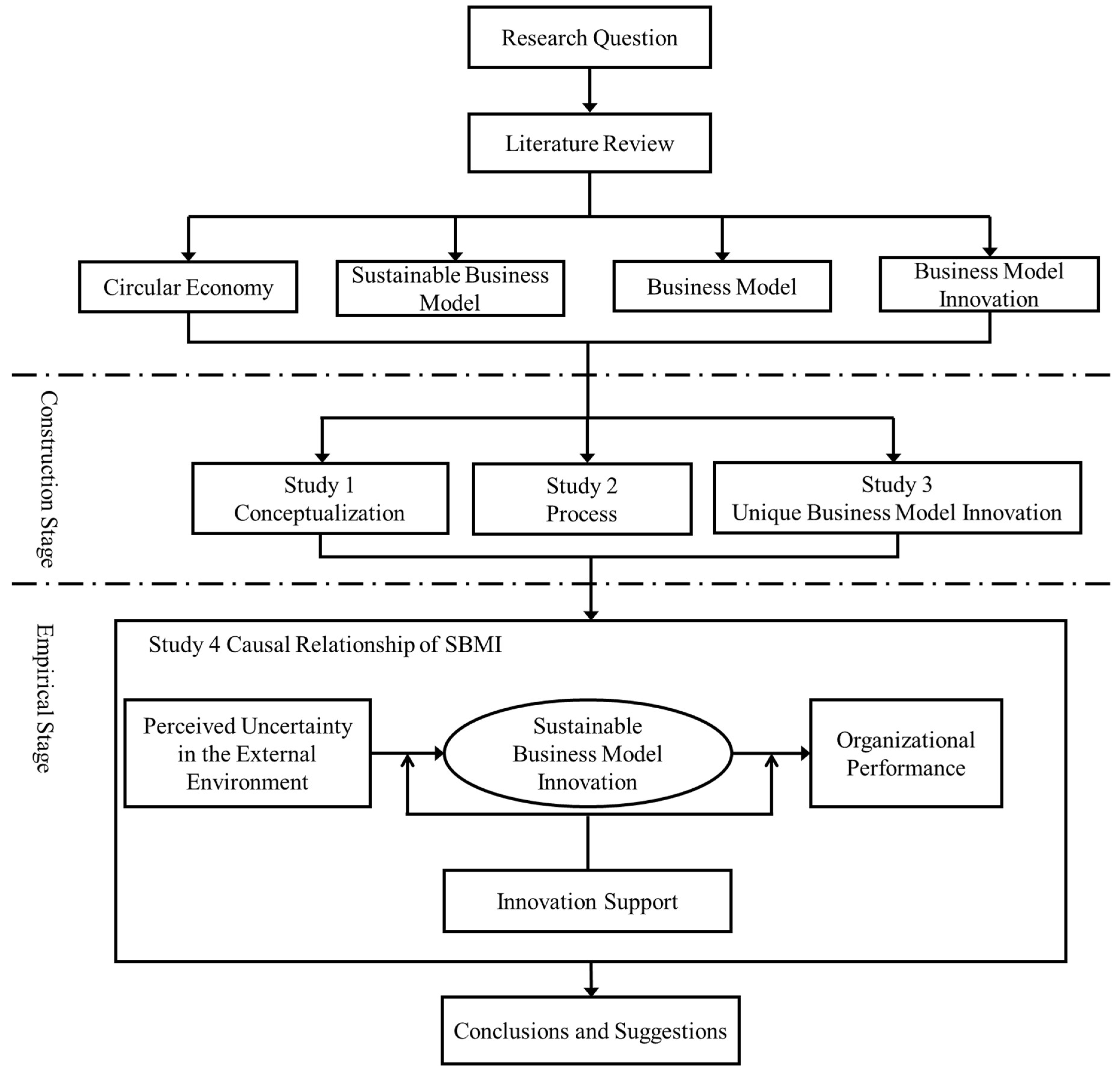
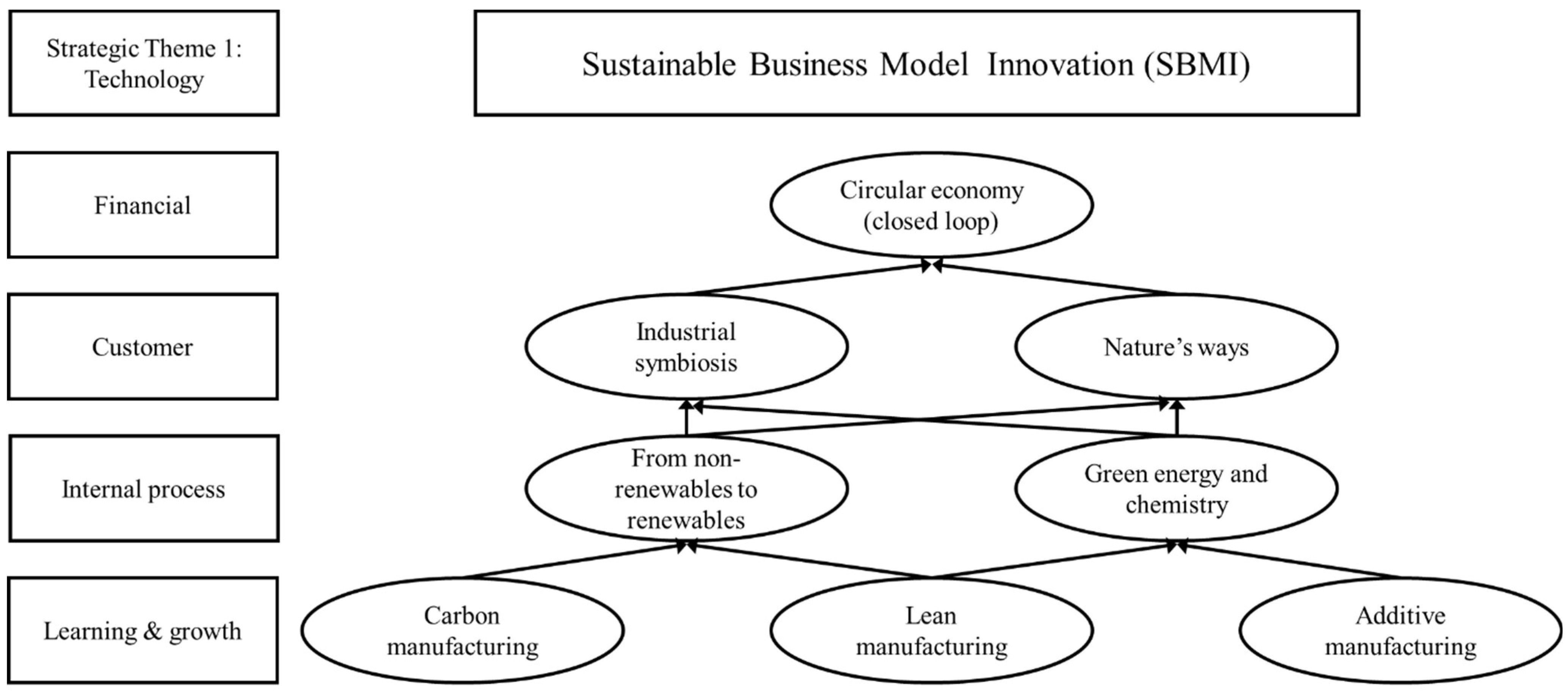
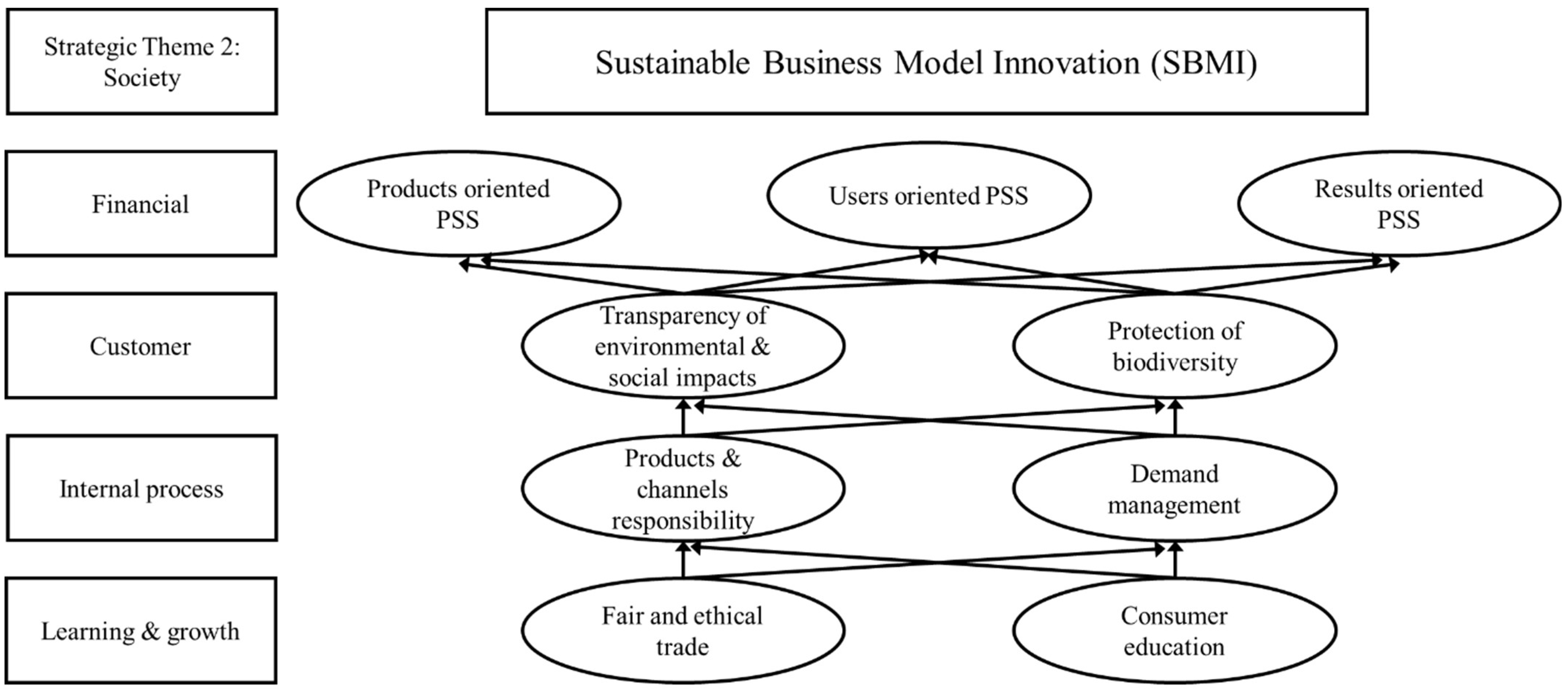
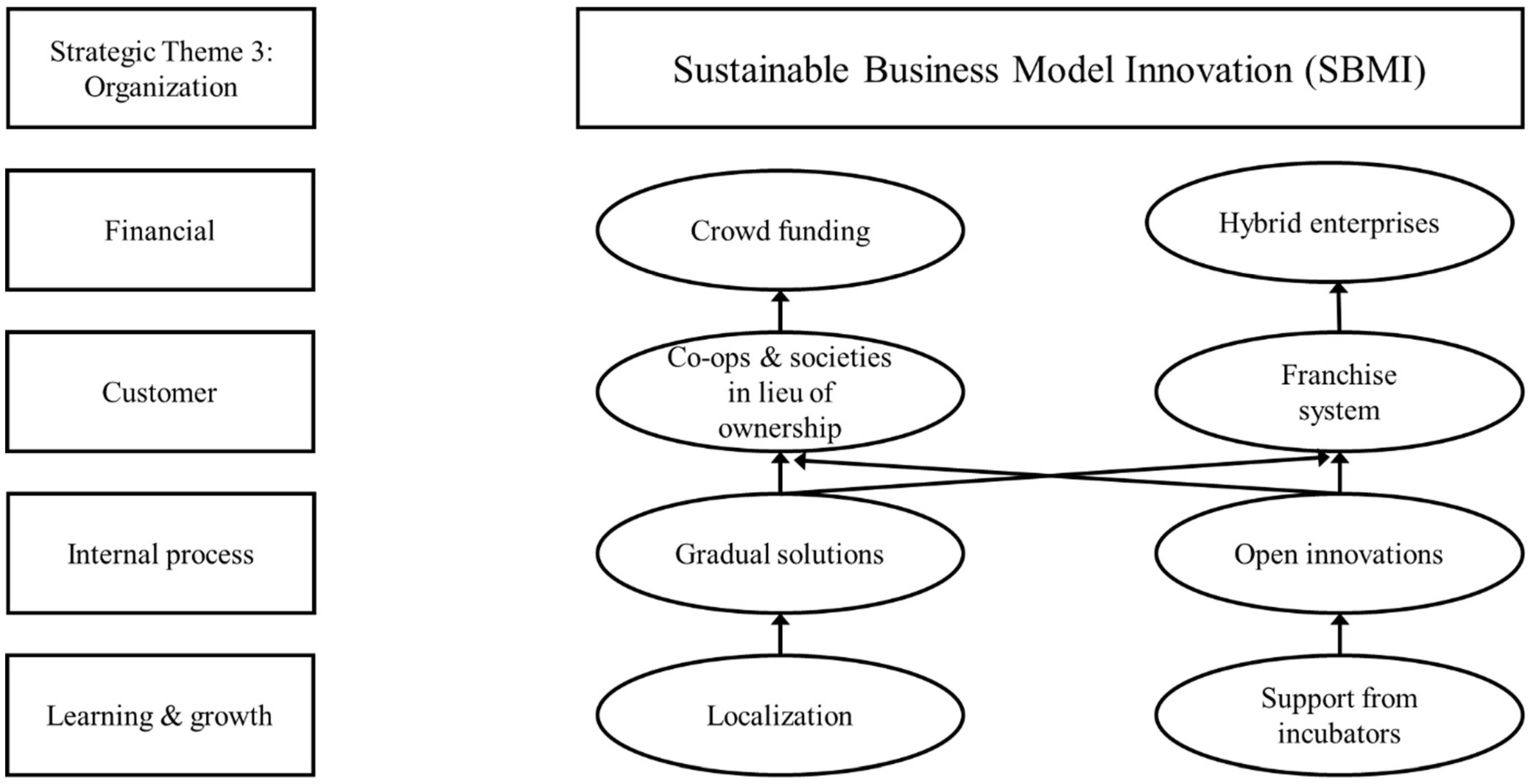
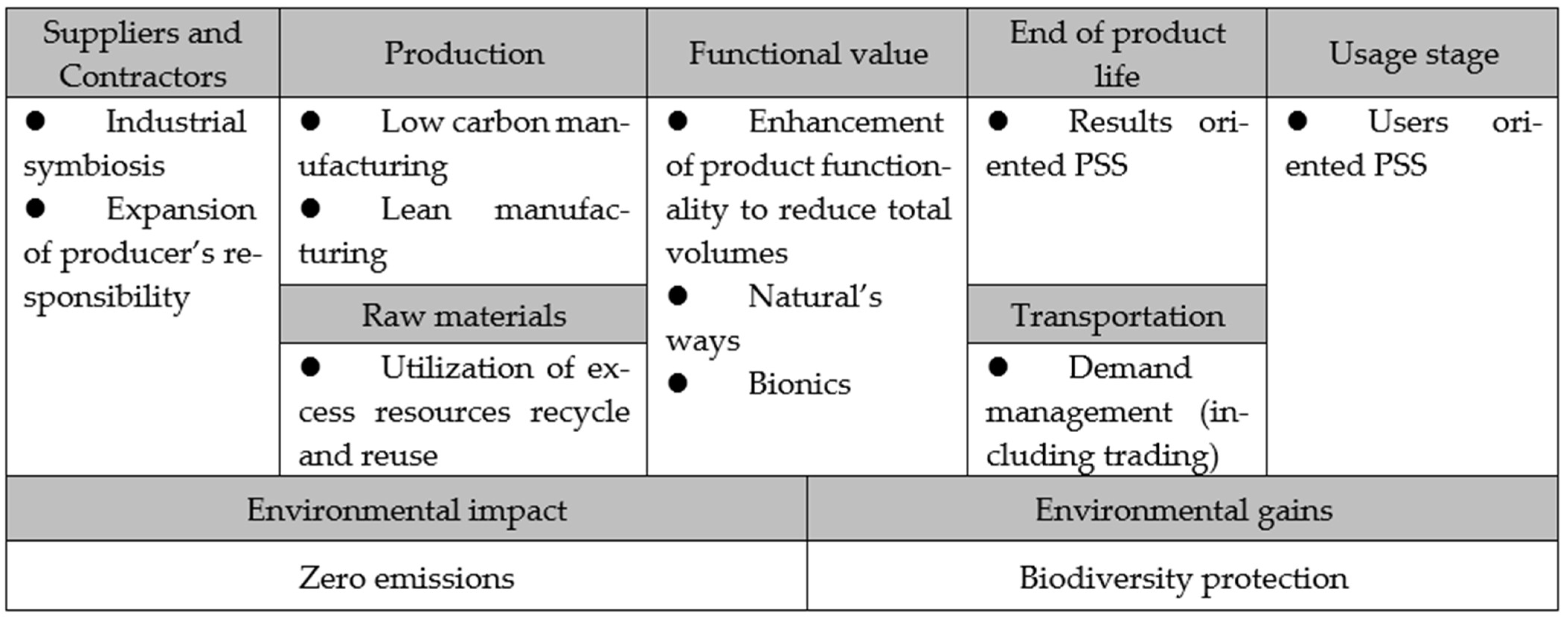

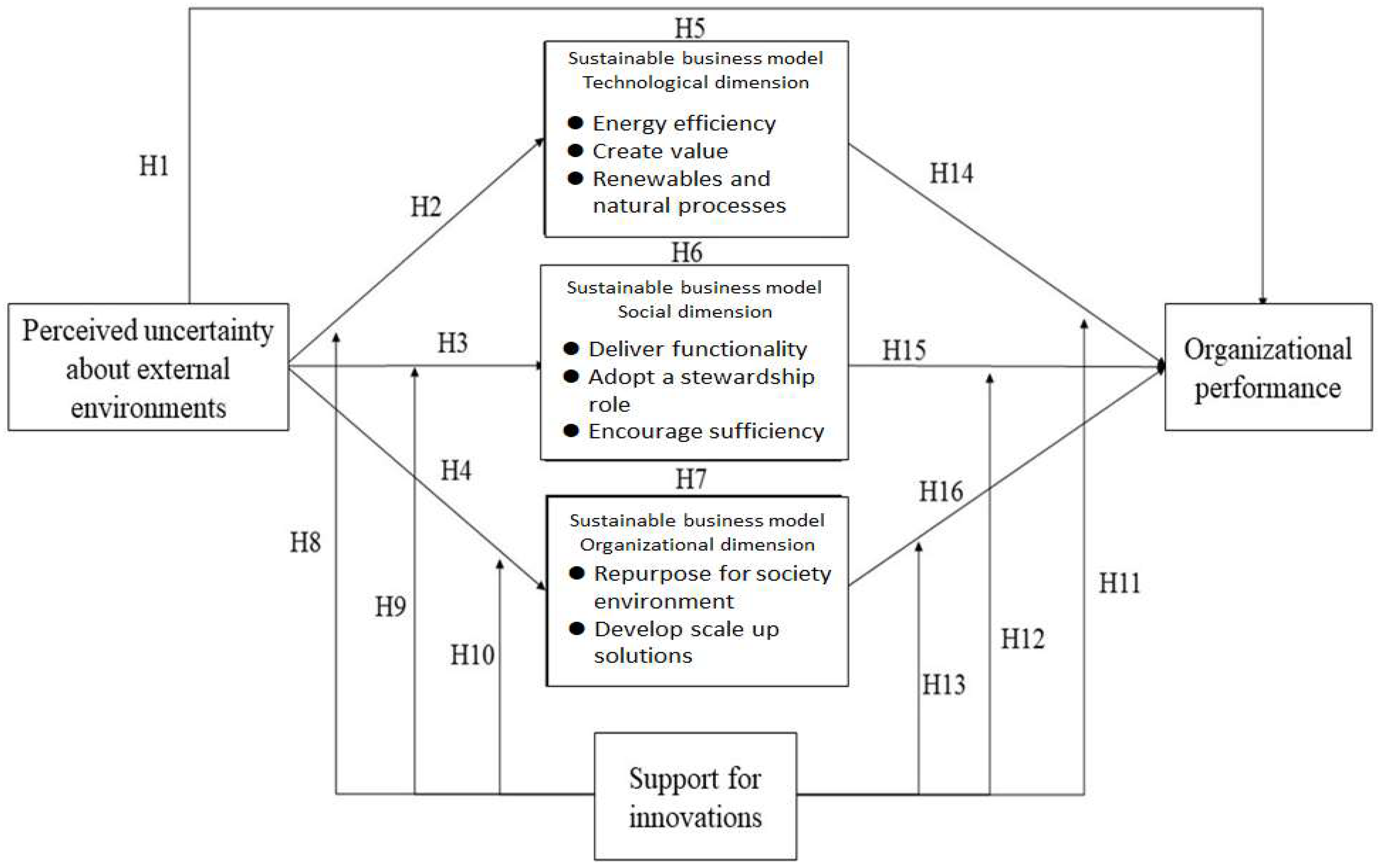
| Dimension (Cronbach’s α) | Item | Factor Loading | Eigenvalue | Cumulative Variance Explained | Item-Total Correlation |
|---|---|---|---|---|---|
| Maximize material and energy effectiveness (0.835) | 1. Low carbon manufacturing/solution | 0.906 | 2.679 | 66.986 | 0.801 |
| 4. Increased functionality (to reduce total number of packaging) | 0.858 | 0.720 | |||
| 2. Lean manufacturing | 0.810 | 0.647 | |||
| 3. Additive manufacturing | 0.683 | 0.503 | |||
| Create value from waste (0.897) | 6. Cradle 2 Cradle | 0.907 | 3.994 | 66.572 | 0.851 |
| 10. Extended producer responsibility | 0.843 | 0.763 | |||
| 7. Industrial symbiosis | 0.840 | 0.751 | |||
| 9. Take back management | 0.829 | 0.741 | |||
| 8. Reuse, recycle, re-manufacture | 0.785 | 0.687 | |||
| 5. Circular economy, close loop | 0.672 | 0.559 | |||
| Substitute with renewables and natural processes (0.958) | 14. Green chemistry | 0.963 | 3.552 | 88.811 | 0.930 |
| 13. The natural step (blue economy, bio-mimicry) | 0.959 | 0.925 | |||
| 12. Zero emissions initiative | 0.928 | 0.874 | |||
| 11. Move from non-renewable energy sources | 0.918 | 0.857 |
| Dimension (Cronbach’s α) | Item | Factor Loading | Eigenvalue | Cumulative Variance Explained | Item-Total Correlation |
|---|---|---|---|---|---|
| Deliver functionality rather than ownership (0.910) | 15. Product-oriented PSS—maintenance extended warrantee | 0.941 | 2.543 | 84.769 | 0.861 |
| 16. User oriented PSS—rental, lease, shared | 0.935 | 0.849 | |||
| 17. Result-oriented PSS—pay per use | 0.885 | 0.755 | |||
| Adopt a stewardship role (0.915) | 18. Biodiversity protection | 0.739 | 3.769 | 75.373 | 0.625 |
| 19. Ethical trade (fair trade) | 0.915 | 0.857 | |||
| 20. Choice editing by retailers | 0.879 | 0.797 | |||
| 21. Radical transparency about environmental/societal impacts | 0.928 | 0.873 | |||
| 22. Resource stewardship | 0.868 | 0.779 | |||
| Encourage sufficiency (0.929) | 23. Consumer education (models); communication and awareness | 0.902 | 2.627 | 87.576 | 0.790 |
| 24. Demand management (including cap and trade) | 0.956 | 0.894 | |||
| 25. Responsible product distribution/promotion | 0.949 | 0.879 |
| Dimension (Cronbach’s α) | Item | Factor Loading | Eigenvalue | Cumulative Variance Explained | Item-Total Correlation |
|---|---|---|---|---|---|
| Repurpose for society environment (0.895) | 26. Hybrid businesses, social enterprise (for profit) | 0.780 | 4.043 | 67.391 | 0.666 |
| 27. Alternative ownership: cooperative, mutual, (farmers)collectives | 0.882 | 0.805 | |||
| 28. Social and biodiversity regeneration initiatives ("net positive") | 0.887 | 0.826 | |||
| 29. Base of pyramid solutions | 0.888 | 0.813 | |||
| 30. Localization | 0.811 | 0.717 | |||
| 31. Home based, flexible working | 0.651 | 0.536 | |||
| Develop scale-up solutions (0.891) | 32. Incubators and entrepreneur support models | 0.913 | 2.600 | 64.997 | 0.510 |
| 33. Licensing franchising | 0.913 | 0.545 | |||
| 34. Open innovation (platforms) | 0.856 | 0.440 | |||
| 35. Crowd sourcing/funding | 0.447 | 0.292 |
| Variable | Organizational Performance | ||
|---|---|---|---|
| Mode 1 | Mode 2 | Mode 3 | |
| Control variable | |||
| sex | −0.156 | −0.390 *** | −0.152 * |
| Independ variable | |||
| Perceived uncertainty about external environment | 0.657 *** | 0.667 *** | |
| Mediation variable 1 | Sustainable business models—technological dimension | ||
| Maximize material and energy effectiveness | 0.292 *** | −0.019 | |
| R2 | 0.529 | 0.239 | 0.529 |
| Adjusted R2 | 0.523 | 0.229 | 0.521 |
| F value | 89.915 *** | 25.118 *** | 59.637 *** |
| Create value from waste | 0.451 *** | 0.069 | |
| R2 | 0.529 | 0.357 | 0.532 |
| Adjusted R2 | 0.523 | 0.349 | 0.523 |
| F value | 89.915 *** | 44.443 *** | 60.190 *** |
| Substitute with renewables and natural processes | 0.403 *** | 0.043 | |
| R2 | 0.529 | 0.316 | 0.530 |
| Adjusted R2 | 0.523 | 0.307 | 0.521 |
| F value | 89.915 *** | 36.907 *** | 59.849 *** |
| Mediation variable 2 | Sustainable business models—social dimension | ||
| Deliver functionality rather than ownership | 0.492 *** | 0.097 | |
| R2 | 0.529 | 0.393 | 0.534 |
| Adjusted R2 | 0.523 | 0.386 | 0.525 |
| F value | 89.915 *** | 51.834 *** | 60.632 *** |
| Adopt a stewardship role | 0.359 *** | −0.262 ** | |
| R2 | 0.529 | 0.277 | 0.558 |
| Adjusted R2 | 0.523 | 0.268 | 0.549 |
| F value | 89.915 *** | 30.672 *** | 66.812 *** |
| Encourage sufficiency | 0.220 ** | −0.254 *** | |
| R2 | 0.529 | 0.201 | 0.569 |
| Adjusted R2 | 0.523 | 0.191 | 0.561 |
| F value | 89.915 *** | 20.174 *** | 69.910 *** |
| Mediation variable 3 | Sustainable business models—organizational dimension | ||
| Repurpose for society environment | 0.227 ** | −0.211 ** | |
| R2 | 0.529 | 0.205 | 0.558 |
| Adjusted R2 | 0.523 | 0.195 | 0.550 |
| F value | 89.915 *** | 20.628 *** | 66.883 *** |
| Develop scale-up solutions | −0.266 *** | −0.018 | |
| R2 | 0.529 | 0.223 | 0.529 |
| Adjusted R2 | 0.523 | 0.213 | 0.521 |
| F value | 89.915 *** | 22.970 *** | 59.628 *** |
| Variable | Sustainable Business Models—Technological Dimension | ||||||||
|---|---|---|---|---|---|---|---|---|---|
| Maximize Material and Energy Effectiveness | Create Value from Waste | Substitute with Renewables and Natural Processes | |||||||
| Mode 1 | Mode 2 | Mode 3 | Mode 1 | Mode 2 | Mode 3 | Mode 1 | Mode 2 | Mode 3 | |
| Perceived uncertainty about external environment | 0.469 *** | −1.030 *** | 0.625 *** | −0.944 *** | 0.569 *** | −0.665 *** | |||
| Support for innovation | 0.799 *** | −0.526 | 0.875 *** | −0.435 * | 0.810 *** | −0.027 | |||
| Perceived uncertainty about external environment × support for innovation | 4.861 *** | 2.113 *** | 3.616 *** | ||||||
| R2 | 0.220 | 0.638 | 0.718 | 0.391 | 0.766 | 0.828 | 0.323 | 0.656 | 0.685 |
| Adjusted R2 | 0.215 | 0.635 | 0.712 | 0.387 | 0.765 | 0.824 | 0.319 | 0.654 | 0.679 |
| F value | 45.499 *** | 283.332 *** | 134.803 *** | 103.195 *** | 527.910 *** | 254.525 *** | 76.946 *** | 306.916 *** | 115.365 *** |
| Variable | Sustainable business models—social dimension | ||||||||
| Deliver functionality rather than ownership | Adopt a stewardship role | Encourage sufficiency | |||||||
| Mode 1 | Mode 2 | Mode 3 | Mode 1 | Mode 2 | Mode 3 | Mode 1 | Mode 2 | Mode 3 | |
| Perceived uncertainty about external environment | 0.706 *** | 0.044 | 0.761 *** | 0.446 ** | 0.611 *** | 0.239 | |||
| Support for innovation | 0.821 *** | 0.413 | 0.875 *** | 1.020 *** | 0.788 *** | 1.058 *** | |||
| Perceived uncertainty about external environment × support for innovation | 0.392 | −0.502 * | −0.470 | ||||||
| R2 | 0.498 | 0.674 | 0.694 | 0.579 | 0.766 | 0.794 | 0.373 | 0.621 | 0.625 |
| Adjusted R2 | 0.495 | 0.672 | 0.689 | 0.576 | 0.764 | 0.790 | 0.369 | 0.619 | 0.618 |
| F value | 159.591 *** | 332.767 *** | 120.480 *** | 221.234 *** | 525.861 *** | 204.274 *** | 95.696 *** | 263.664 *** | 88.220 *** |
| Variable | Sustainable business models—organization dimension | ||||||||
| Repurpose for society environment | Develop scale-up solutions | ||||||||
| Mode 1 | Mode 2 | Mode 3 | Mode 1 | Mode 2 | Mode 3 | ||||
| Perceived uncertainty about external environment | 0.574 *** | −0.412 ** | 0.372 *** | −0.543 * | |||||
| Support for innovation | 0.854 *** | 0.559 * | 0.530 *** | −0.188 | |||||
| Perceived uncertainty about external environment × support for innovation | 0.632 | 1.177 * | |||||||
| R2 | 0.329 | 0.729 | 0.744 | 0.138 | 0.280 | 0.300 | |||
| Adjusted R2 | 0.325 | 0.727 | 0.740 | 0.133 | 0.276 | 0.287 | |||
| F value | 79.057 *** | 433.123 *** | 154.306 *** | 25.879 *** | 62.740 *** | 22.735 *** | |||
| Variable | Organizational Performance | ||||||
|---|---|---|---|---|---|---|---|
| Mode 1 | Mode 2 | Mode 3 | Mode 4 | Mode 5 | Mode 6 | Mode 7 | |
| Technological dimension | |||||||
| Support for innovation | 0.461 *** | −0.662 ** | −0.768 *** | −0.406 * | |||
| Maximize material and energy effectiveness | 0.295 *** | −1.417 *** | |||||
| Create value from waste | 0.446 *** | −1.253 *** | |||||
| Substitute with renewables and natural processes | 0.399 *** | ||||||
| Maximize material and energy effectiveness × support for innovation | 2.407 *** | −1.637 *** | |||||
| Create value from waste × support for innovation | 2.460 *** | ||||||
| Substitute with renewables and natural processes × support for innovation | 2.438 *** | ||||||
| R2 | 0.213 | 0.087 | 0.199 | 0.159 | 0.403 | 0.379 | 0.346 |
| Adjusted R2 | 0.208 | 0.081 | 0.194 | 0.154 | 0.392 | 0.367 | 0.334 |
| F value | 43.553 *** | 15.297 *** | 39.920 *** | 30.487 *** | 35.797 *** | 32.298 *** | 28.058 *** |
| Variable | Organizational Performance | ||||||
|---|---|---|---|---|---|---|---|
| Mode 1 | Mode 2 | Mode 3 | Mode 4 | Mode 5 | Mode 6 | Mode 7 | |
| Social dimension | |||||||
| Support for innovation | 0.461 *** | −0.828 *** | −0.782 *** | −0.708 ** | |||
| Deliver functionality rather than ownership | 0.523 *** | −1.039 *** | −0.976 *** | −1.303 *** | |||
| Adopt a stewardship role | 0.422 *** | ||||||
| Encourage sufficiency | 0.263 *** | ||||||
| Deliver functionality rather than ownership × support for innovation | 2.333 *** | ||||||
| Adopt a stewardship role × support for innovation | 2.192 *** | ||||||
| Encourage sufficiency × support for innovation | 2.323 *** | ||||||
| R2 | 0.213 | 0.274 | 0.178 | 0.069 | 0.418 | 0.365 | 0.407 |
| Adjusted R2 | 0.208 | 0.269 | 0.173 | 0.063 | 0.407 | 0.353 | 0.396 |
| F value | 43.553 *** | 60.642 *** | 34.802 *** | 11.975 *** | 38.029 *** | 30.514 *** | 36.369 *** |
| Variable | Organizational Performance | ||||
|---|---|---|---|---|---|
| Mode 1 | Mode 2 | Mode 3 | Mode 4 | Mode 5 | |
| Organizational dimension | |||||
| Support for innovation | 0.461 *** | −0.139 | 0.030 | ||
| Repurpose for society environment | 0.250 *** | −1.467 *** | −2.531 *** | ||
| Develop scale-up solutions | 0.210 ** | ||||
| Repurpose for society environment × support for innovation | 1.951 *** | ||||
| Develop scale-up solutions × support for innovation | 2.776 *** | ||||
| R2 | 0.213 | 0.062 | 0.044 | 0.426 | 0.340 |
| Adjusted R2 | 0.208 | 0.057 | 0.038 | 0.415 | 0.328 |
| F value | 43.553 *** | 10.732 *** | 7.427 ** | 39.268 *** | 27.308 *** |
Publisher’s Note: MDPI stays neutral with regard to jurisdictional claims in published maps and institutional affiliations. |
© 2022 by the authors. Licensee MDPI, Basel, Switzerland. This article is an open access article distributed under the terms and conditions of the Creative Commons Attribution (CC BY) license (https://creativecommons.org/licenses/by/4.0/).
Share and Cite
Chuang, L.-M.; Lee, Y.-P.; Liu, T.-H. Towards Sustainable Business Model Innovation for the Pharmaceutical Industry. Sustainability 2022, 14, 11760. https://doi.org/10.3390/su141811760
Chuang L-M, Lee Y-P, Liu T-H. Towards Sustainable Business Model Innovation for the Pharmaceutical Industry. Sustainability. 2022; 14(18):11760. https://doi.org/10.3390/su141811760
Chicago/Turabian StyleChuang, Li-Min, Yu-Po Lee, and Te-Hui Liu. 2022. "Towards Sustainable Business Model Innovation for the Pharmaceutical Industry" Sustainability 14, no. 18: 11760. https://doi.org/10.3390/su141811760
APA StyleChuang, L.-M., Lee, Y.-P., & Liu, T.-H. (2022). Towards Sustainable Business Model Innovation for the Pharmaceutical Industry. Sustainability, 14(18), 11760. https://doi.org/10.3390/su141811760











